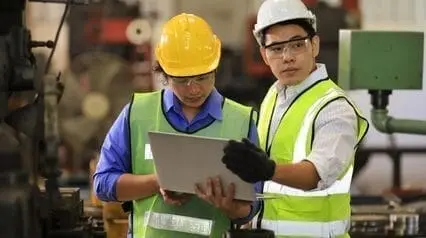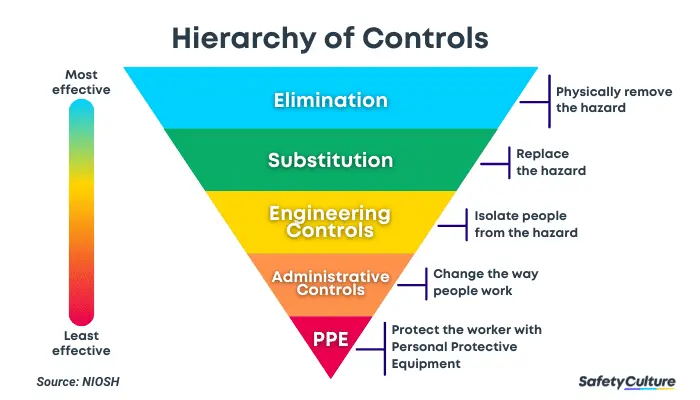What is Control of Work?
“Control of work” refers to the aspect or system of safety management concerned with managing who gets access and control to specific tasks in a project. Control of work can be considered a gate for a workplace, ensuring that only accredited, capable, and safe people can do hazardous and risky tasks such as working in confined spaces, welding, brazing, and the like.
Control of Work System and Process
While there is no one correct way to create and implement a control of work system, it is founded on establishing and managing control measures in the workplace. However, an important part of any control of work system is to identify and establish what the hazards are and the control measures for them.
A good basis to follow for creating a control of work system is by following the hierarchy of controls used by both the US Occupational Safety and Health Administration (OSHA) and the UK’s Health and Safety Executive (HSE). The hierarchy of controls is a set of control measures or actions professionals from different industries use to reduce the risks of any hazards in their respective lines of work. It is also often drawn in an inverted triangle format to show what is the most to least effective way to reduce risk.
In order of most to least effective, the levels of the hierarchy of controls are:
- Elimination: Removing the hazard or risk entirely from the situation
- Substitution: Replacing or changing the item or causing a hazard with a safer alternative to mitigate risks
- Engineering Controls: Replacing the equipment used to be used or changing the employees’ immediate work environment to separate them from a hazard and reduce risks
- Administrative Controls: Creating and implementing new processes that can help employees work safely in anticipated conditions
- Personal Protective Equipment (PPE): Equipping workers with work-specific PPE to reduce the risk of injury, harm, and death
Alongside taking the necessary control measures, it is also essential to have a Permit to Work (PTW) system in place with your control of work system. After understanding and reducing or mitigating the risks and hazards as much as possible, you should implement a PTW system so only those authorized to do a certain task will have access to the materials and site for it.
For example, in a manufacturing site, not everyone will be allowed to work on everything. This can be due to safety reasons or lack of experience. With a PTW, only specific staff will be able to work with certain equipment and do certain tasks, as they will be the only ones authorized to do so.
Create Your Own Control of Work Audit Checklist
Eliminate manual tasks and streamline your operations.
Get started for FREE
The same can be said for specialized industries such as fire protection. With a PTW, only firefighters will be permitted to use their trucks and do certain tasks as they have the necessary training and equipment for it.
Importance of Implementing a Control of Work System
Most construction, manufacturing, engineering, and other high-risk or high-hazard jobs require a control of work system. The primary reason for this is to ensure workplace safety. With control measures in place, employers can make sure that only those with the right qualifications, experience, and safety gear can proceed with a certain task.
Both the US OSHA and the UK’s HSE require employers to have their control of work systems in place in their respective workplaces as they are morally and legally responsible for their employee’s safety in the workplace at all times.
A control of work system also guarantees that certain hazardous equipment is only used by authorized personnel for certain jobs, meaning those without the necessary experience or ability to use them cannot. Not only does this establish safety in the workplace, but it also ensures that quality work is done by only those capable of doing it.
Another reason for having a control of work system is to keep visitors, temporary workers, and the like from entering unsafe places without the proper safety equipment. In particular, visitors to a hazardous worksite are often not trained or approved for many of the tasks there, so having a control of work system ensures they are safe and away from risks they are not prepared to handle.
FAQs about Control of Work
The employer of any employee should implement the organization’s control of work system. However, it is also the responsibility of project heads, team leaders, and immediate supervisors to do the same on a regular basis and a smaller scale.
Yes, both safety controls and the hierarchy of controls pertain to the actions that can be done to reduce risk or hazards. However, the term “hierarchy of controls” is often associated with the visual of an inverted triangle that shows safety controls organized from most to least effective.
Control of work is an aspect of risk management and assessment. As control of work deals with managing who has access to certain tasks and equipment, it falls under risk management and assessment.
No, all jobs and industries have their own control of work systems in place. However, some do not call it “control of work” and instead call it “control measures” or something else.





